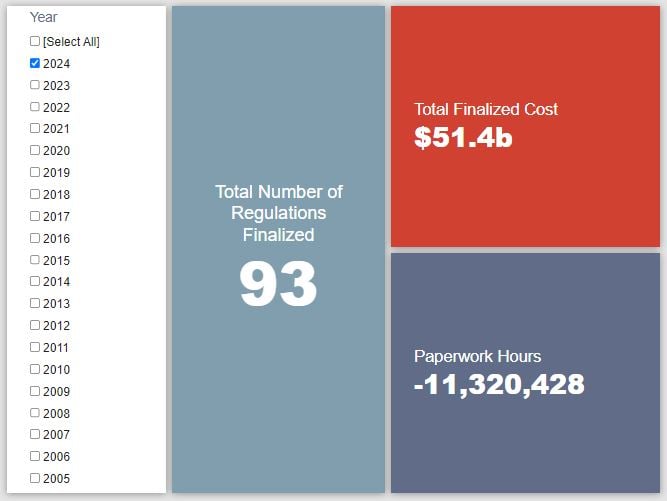Week in Regulation
April 15, 2024
Cost Savings From Temporary Employment Authorization Measure Dominate Week
This past week was a steadily busy one in the pages of the Federal Register. There were 14 rulemakings with some quantifiable economic impact, including a handful that measured in the hundreds of millions of dollars. The most significant action of the bunch was a Department of Homeland Security (DHS) rule setting a temporary “automatic extension period” for immigrants in the country under an employment authorization that could yield sizable cost savings for certain employers. Across all rulemakings, agencies published $4.9 billion in total cost savings but added 527,194 annual paperwork burden hours.
REGULATORY TOPLINES
- Proposed Rules: 44
- Final Rules: 69
- 2024 Total Pages: 26,063
- 2024 Final Rule Costs: $51.4 billion
- 2024 Proposed Rule Costs: $33.9 billion
NOTABLE REGULATORY ACTIONS
The most consequential rulemaking of the week was a “temporary final rule” from DHS establishing a “Temporary Increase of the Automatic Extension Period of Employment Authorization and Documentation for Certain Employment Authorization Document Renewal Applicants.” The rule:
Amends existing Department of Homeland Security (DHS) regulations to provide that the automatic extension period applicable to expiring Employment Authorization Documents (Forms I-766 or EADs) for certain renewal applicants who have filed Form I-765, Application for Employment Authorization (EAD application), will be increased from up to 180 days to up to 540 days from the expiration date stated on their EADs.
DHS is promulgating this rule out of concern that “approximately 800,000 renewal applicants will be in danger of losing their employment authorization and/or documentation in the period beginning May 2024 and ending March 2026.” As the rule’s economic analysis section discusses extensively, this reauthorization period will have myriad impacts on the transfer payments between covered employees and employers that are largely dependent upon how the relevant labor markets shake out in coming years. In terms of clear cost savings, however, DHS expects the rule to result in lower “labor turnover costs” (essentially the costs of separating from current employees and finding new ones to replace them) for the employers involved. The agency’s primary estimate of this effect is roughly $1.1 billion in annualized savings, or $5.2 billion over a five-year horizon.
TRACKING THE ADMINISTRATIONS
As we have already seen from executive orders and memos, the Biden Administration will surely provide plenty of contrasts with the Trump Administration on the regulatory front. And while there is a general expectation that the current administration will seek to broadly restore Obama-esque regulatory actions, there will also be areas where it charts its own course. Since the AAF RegRodeo data extend back to 2005, it is possible to provide weekly updates on how the top-level trends of President Biden’s regulatory record track with those of his two most recent predecessors. The following table provides the cumulative totals of final rules containing some quantified economic impact from each administration through this point in their respective terms.![]() The temporary employment authorization rule discussed above included enough in cost savings to push the Biden-era cost tally back under the $500 billion threshold. Nevertheless, that total continues to exceed the entire first term of the Obama Administration – a mark it passed in the prior week. Check out the latest episode of the AAF Exchange for further discussion of that development.
The temporary employment authorization rule discussed above included enough in cost savings to push the Biden-era cost tally back under the $500 billion threshold. Nevertheless, that total continues to exceed the entire first term of the Obama Administration – a mark it passed in the prior week. Check out the latest episode of the AAF Exchange for further discussion of that development.
For the other two administrations, there was only modest upward movement in their respective final rule metrics. The Trump Administration saw costs and paperwork increase by nearly $365 million and 828,000 hours, respectively. The rule implementing “Paid Leave Under the Families First Coronavirus Response Act” was the primary driver of that shift. Meanwhile, an April 2012 rule regarding “Changes to the Medicare Advantage and the Medicare Prescription Drug Benefit Programs for Contract Year 2013 and Other Changes” was the main reason the Obama Administration saw cost and paperwork increases of $263 million and 279,000 hours.
TOTAL BURDENS
Since January 1, the federal government has published $85.3 billion in total net costs (with $51.4 billion in new costs from finalized rules) and 9.1 million hours of net annual paperwork burden increases (with 11.3 million hours in reductions coming from final rules). 










